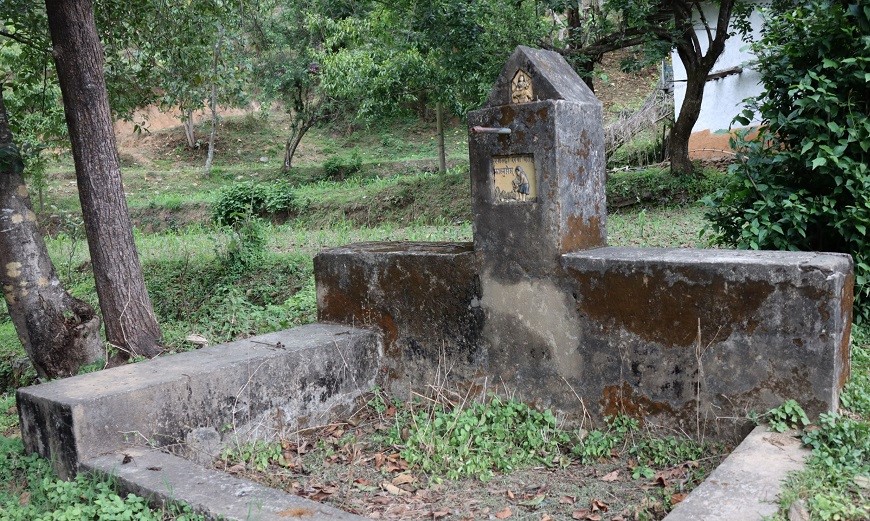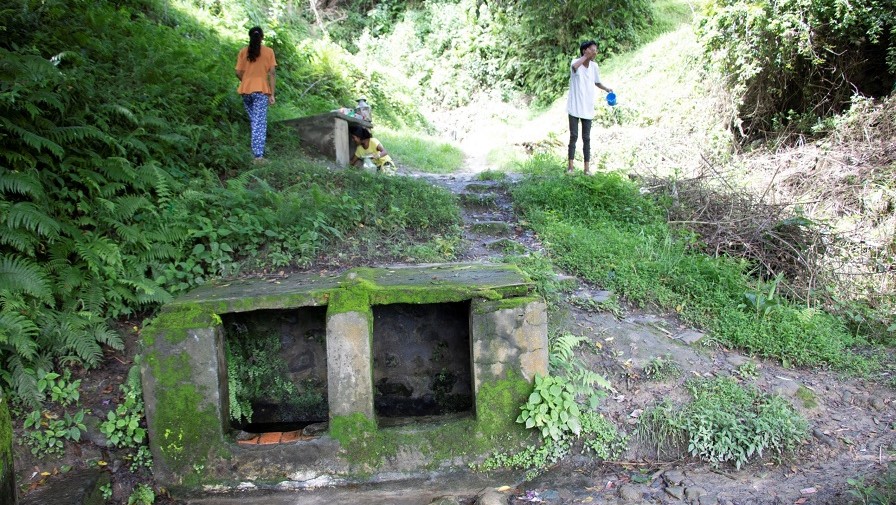Nepal’s springs crisis may worsen due to bore wells
Written by Anushiya Shrestha, Gyanu Maskey, Salu Basnet
Natural springs are an important source of water for the people of the Himalayas, but these water sources are susceptible to the impacts of both climate change and human interventions. A 2021 study conducted in Nepal’s western hilly areas found that water flow has declined in over 70% of the region’s springs, with significant declines noted in the last 10 years.
The alarming rate at which springs are drying up has resulted in extreme water stress threatening the livelihoods of much of the Himalayan population. There are many causes behind the decline of springs, including changing rainfall patterns and increasing water usage. Our ongoing research, along with several other studies, has highlighted how anthropogenic issues – such as land-use changes triggered by demographic shifts and haphazard excavation of mountainsides for roads and other large infrastructure projects – have also contributed to Nepal’s springs crisis.

A dry and deserted public tap (Image: Southasia Institute of Advanced Studies)
Blaming climate change
An emerging trend that we have noted among municipal government officials in Nepal is to place the blame for drying springs almost exclusively on climate change, and to promote more human intervention as a solution. A key informant in our study – who is also the head of a municipality – told our research team: “Investing in springs is not worth [it] as the spring sources are affected by climate change. Deep boring would, [instead] be a reliable alternative for urbanising areas.”
A deep bore well involves drilling a narrow pipe, usually about 15 centimetres in width, dozens or even a hundred feet or more into an aquifer to extract water. But deep bore wells draw up scarce groundwater, and a 2012 study conducted in Nepal’s central Himalayan region found that groundwater contributed six times more water to springs than glaciers and snowmelt. In 2018, an ICIMOD study suggested that if drying springs are the problem, deep bore wells will only make that problem worse, and as such they cannot be a long-term solution. Yet years later, deep bore wells are still being pushed, overlooking the fragility of the Himalayan landscape.
With this focus on adoption of exploitative, maladaptive practices, conservation of spring sources has not been prioritised. Although efforts to restore ponds and recharge aquifers have been initiated in some areas of Nepal, conservation of water structures is often neglected. For instance, we found that a newly constructed recharge pond in our study site in a Nepali hilltop town was neglected after its construction. Our conversations with municipal representatives and local communities revealed that although it was referred to as a ‘recharge pond’, the sole intention behind the huge investment involved in its construction was tourism promotion, without attention paid to its efficacy in recharging groundwater.
In the course of our research – ongoing since 2021 – communities with whom we interacted have been unconvinced by those offering deep bore wells as a solution to Nepal’s drying springs. As one respondent said: “Our spring water sources [are] a more sustainable option for our hilly terrain.” Even the chairperson of a deep bore well-fed system asserted, “We have been using the spring sources in the region for generations; their discharge is higher than that of the deep bore well.”
Local governments in action
Given this scenario, the priorities set by municipal governments – who are the immediate point of contact for the people of Nepal’s mountains – have important implications for spring water management. The overt focus of Nepal’s municipal governments to date on infrastructure-led development has triggered landslides, often blocking spring sources. Likewise, the continued interest from municipalities in pursuing project-driven alternatives to springshed conservation, like establishing large-scale water supply systems including deep bore wells, has undermined the prospect of a springshed management approach.
Based on our research in multiple municipalities, such a quick-fix approach to water management receives priority because it shows early results, allowing long-term problems such as loss of spring sources and over-exploitation of deep aquifers to be ignored.
Investment in new technocratic alternatives has often come at the cost of support for the conservation of local springs and improved management of water systems fed by those springs. Municipal governments legitimise their decisions by referring to climate change and arguing that springs are ‘not reliable’ due to the impacts of climate change. Meanwhile, with promises of improved water access thanks to these interventions, communal water demand has surged just as many communities have opted out of maintaining and conserving local spring sources. Consequently, exploitation and degradation of these key water sources has intensified, increasing water insecurity, particularly for poor households.

A neglected natural spring in Nepal (Image: Southasia Institute of Advanced Studies)
Since municipal governments are at the frontline of delivering equitable, sustainable and resilient water services, improving their understanding of the climatic and non-climatic factors that affect water sources and the socioeconomic and environmental impacts of overexploitation of aquifers in the inherently fragile Himalayan region is an urgent task. Concerted and coordinated cross-sectoral and cross-scalar efforts are crucial to help municipal governments to monitor, revive and recharge water sources and undertake systematic springshed management activities.
Equally important is to foster equitable exchange of expert and indigenous knowledge and perspectives as an integral component in the design and implementation of municipal water management plans, and to encourage collective action towards the sustainable and effective use and protection of water sources.
Acknowledgement: This article is based on research conducted under the PolCaps and JustClime projects at the Southasia Institute of Advanced Studies-SIAS. The authors thank Hemant Ojha for his feedback on an earlier draft.
This article originally appeared on The Third Pole. Read the original article here.

